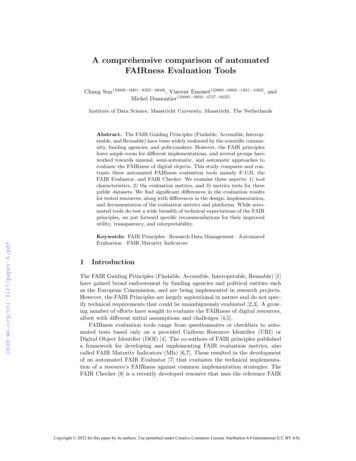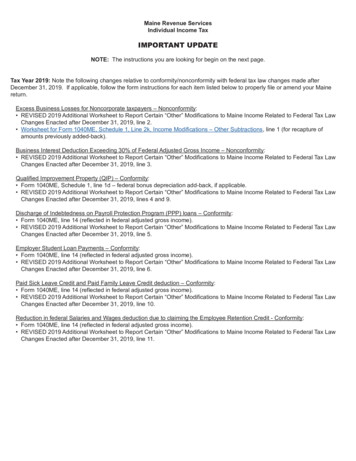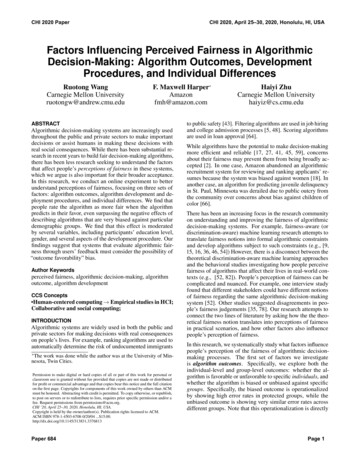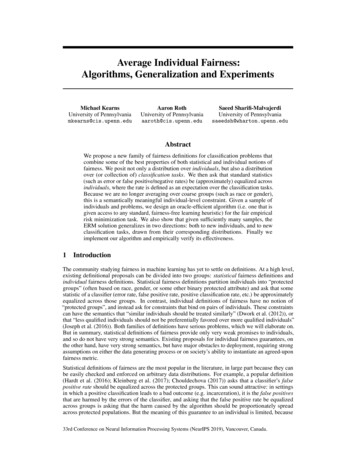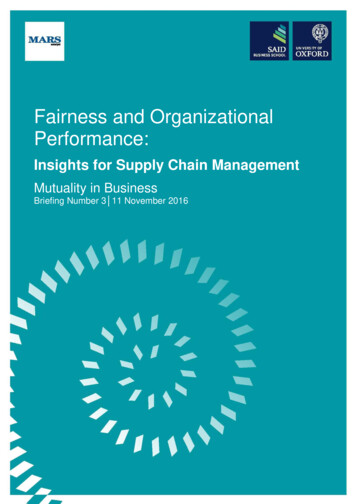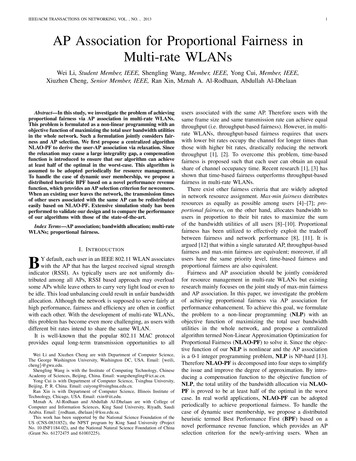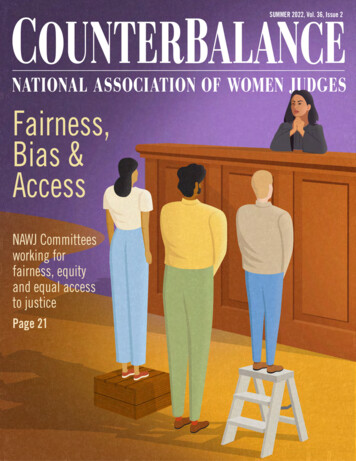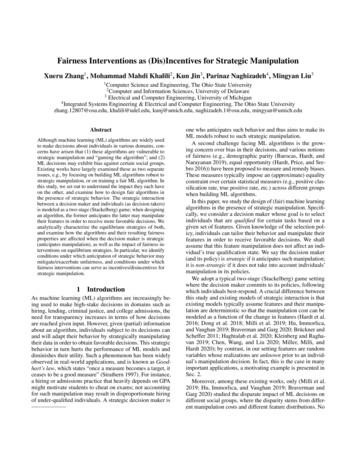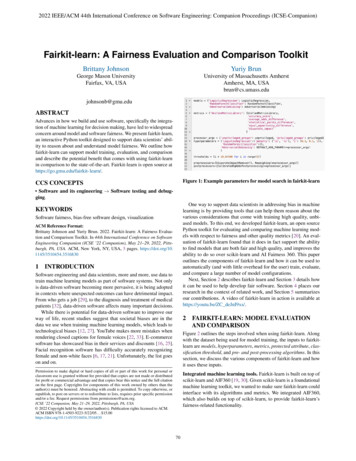
Transcription
2022 IEEE/ACM 44th International Conference on Software Engineering: Companion Proceedings (ICSE-Companion)Fairkit-learn: A Fairness Evaluation and Comparison ToolkitBrittany JohnsonYuriy BrunGeorge Mason UniversityFairfax, VA, USAUniversity of Massachusetts AmherstAmherst, MA, es in how we build and use software, specifically the integration of machine learning for decision making, have led to widespreadconcern around model and software fairness. We present fairkit-learn,an interactive Python toolkit designed to support data scientists’ ability to reason about and understand model fairness. We outline howfairkit-learn can support model training, evaluation, and comparisonand describe the potential benefit that comes with using fairkit-learnin comparison to the state-of-the-art. Fairkit-learn is open source athttps://go.gmu.edu/fairkit-learn/.Figure 1: Example parameters for model search in fairkit-learnCCS CONCEPTS Software and its engineering Software testing and debugging.One way to support data scientists in addressing bias in machinelearning is by providing tools that can help them reason about thevarious considerations that come with training high quality, unbiased models. To this end, we developed fairkit-learn, an open sourcePython toolkit for evaluating and comparing machine learning models with respect to fairness and other quality metrics [20]. An evaluation of fairkit-learn found that it does in fact support the abilityto find models that are both fair and high quality, and improves theability to do so over scikit-learn and AI Fairness 360. This paperoutlines the components of fairkit-learn and how it can be used toautomatically (and with little overhead for the user) train, evaluate,and compare a large number of model configurations.Next, Section 2 describes fairkit-learn and Section 3 details howit can be used to help develop fair software. Section 4 places ourresearch in the context of related work, and Section 5 summarizesour contributions. A video of fairkit-learn in action is available athttps://youtu.be/ZC deJnI9xs/.KEYWORDSSoftware fairness, bias-free software design, visualizationACM Reference Format:Brittany Johnson and Yuriy Brun. 2022. Fairkit-learn: A Fairness Evaluation and Comparison Toolkit. In 44th International Conference on SoftwareEngineering Companion (ICSE ’22 Companion), May 21–29, 2022, Pittsburgh, PA, USA. ACM, New York, NY, USA, 5 pages. ONSoftware engineering and data scientists, more and more, use data totrain machine learning models as part of software systems. Not onlyis data-driven software becoming more pervasive, it is being adoptedin contexts where unexpected outcomes can have detrimental impact.From who gets a job [29], to the diagnosis and treatment of medicalpatients [32], data-driven software affects many important decisions.While there is potential for data-driven software to improve ourway of life, recent studies suggest that societal biases are in thedata we use when training machine learning models, which leads totechnological biases [12, 27]. YouTube makes more mistakes whenrendering closed captions for female voices [22, 33]. E-commercesoftware has showcased bias in their services and discounts [16, 25].Facial recognition software has difficulty accurately recognizingfemale and non-white faces [6, 17, 21]. Unfortunately, the list goeson and on.2FAIRKIT-LEARN: MODEL EVALUATIONAND COMPARISONFigure 2 outlines the steps involved when using fairkit-learn. Alongwith the dataset being used for model training, the inputs to fairkitlearn are models, hyperparameters, metrics, protected attribute, classification threshold, and pre- and post-processing algorithms. In thissection, we discuss the various components of fairkit-learn and howit uses these inputs.Permission to make digital or hard copies of all or part of this work for personal orclassroom use is granted without fee provided that copies are not made or distributedfor profit or commercial advantage and that copies bear this notice and the full citationon the first page. Copyrights for components of this work owned by others than theauthor(s) must be honored. Abstracting with credit is permitted. To copy otherwise, orrepublish, to post on servers or to redistribute to lists, requires prior specific permissionand/or a fee. Request permissions from permissions@acm.org.ICSE ’22 Companion, May 21–29, 2022, Pittsburgh, PA, USA 2022 Copyright held by the owner/author(s). Publication rights licensed to ACM.ACM ISBN 978-1-4503-9223-5/22/05. . . ated machine learning tools. Fairkit-learn is built on top ofscikit-learn and AIF360 [19, 30]. Given scikit-learn is a foundationalmachine learning toolkit, we wanted to make sure fairkit-learn couldinterface with its algorithms and metrics. We integrated AIF360,which also builds on top of scikit-learn, to provide fairkit-learn’sfairness-related functionality.70
ICSE ’22 Companion, May 21–29, 2022, Pittsburgh, PA, USA ! # % ' %Outputs:UnifiedMetricLibrary # '& ' ModelSearchInputs:Johnson and Brun ' ! ! ! " %Figure 2: Fairkit-learn workflow, all of which takes place within your Python code and execution environment.Figure 3: Fairkit learn’s output visualization for the search parameters in Figure 1. Equal opportunity difference, which requires that false negative rates among groups are equal [10, 15]. Causal fairness, also called counterfactual fairness, requiresclassifiers to predict the same outcome for two individualsthat s differ only in protected attributes, and are otherwiseidentical [12, 23].Fairkit-learn supports all of scikit-learn’s and AIF360’s algorithms and metrics, including all of AIF360’s bias mitigating algorithms. Fairkit-learn is currently capable of working with over 70definition of fairness, including: Disparate impact, which measures if a model treats similarlythe same fraction of individuals of each group [10, 14, 37]. Demographic parity, also called statistical parity and groupfairness, which measures if a model’s predictions are statistically independent of the attribute with respect to which themodel is fair [8, 11].Fairkit-learn also provides extension points for including additional metrics and algorithms. Fairkit-learn builds on the contributions of scikit-learn and AI Fairness 360 by providing the followingunique features, which we discuss in more detail next:71
Fairkit-learn: A Fairness Evaluation and Comparison ToolkitICSE ’22 Companion, May 21–29, 2022, Pittsburgh, PA, USA An automated model search capable of evaluating thousandsof machine learning models with respect to two quality and/orfairness metrics simultaneously. An interactive visualization that allows users to explore andcompare a small, Pareto-optimal set of models for each set ofmetrics selected.3USING FAIRKIT-LEARN TO FINDOPTIMAL MODELSFairkit-learn is an open source Python toolkit that supports interactive evaluation and comparison of machine learning models forfairness and other quality metrics simultaneously. It can evaluatethousands of models produced by multiple machine learning algorithms, hyperparameters, and data permutations, and computethen visualize a small Pareto-optimal set of models that providean optimal balance between fairness and quality. Data scientistscan then iterate, improving their models and evaluating them using fairkit-learn. Instructions for installing fairkit-learn, along witha tutorial implemented in a Jupyter notebook, can be found here:https://go.gmu.edu/fairkit-learnTo better understand how a data scientist could use fairkit-learnto train, evaluate, and compare machine learning models, let us lookback at the search written in Figure 1. Here, the user wants to compare the resulting models from three algorithms: LogisticRegression, RandomForestClassifier, and AdversarialDebiasing.In this example, she is using the COMPAS recidivism dataset, whichcontains recidivism data for Browards County between the years2013 and 2014 [28]. Let us imagine that the user wants to exploremodels that best balance accuracy and fairness; one could chooseany metric for each of these concerns, however, she cares about theaccuracy score and the disparate impact.While the user has only entered three learning algorithms, fairkitlearn will train approximately 80 different models by using thehyperparameter value ranges specified to vary the hyperparametervalues in the grid-search. The grid-search will produce a substantiallysmaller subset of models (in this case, the output includes only 7models) that make up the Pareto-optimal set. This smaller set ofmodels is then presented to the user in a visualization that plotsthe models with respect to the metrics chosen by the user; in thiscase, we have disparate impact (a fairness metric) on the x-axis andaccuracy (a quality metric) on the y-axis.The final set of optimal models shown in the visualization aremodels for which improving fairness would decrease accuracy andvice versa (the Pareto-optimal set). For the search shown in Figure 1,the interactive visualization in Figure 3 makes it easy to come realizethat (1) given this dataset (COMPAS), model fairness and accuracyare often in opposition – in other domains they may be complementary, (2) we can achieve a large increase in fairness (69% comparedto 45%) if we sacrifice some accuracy (63% compared to 68%), (3)while adversarial debiasing (magenta) is a fairness-aware algorithm,it produces less fair but slights more accurate models in comparisonto random forest classifier models (orange) that produce more fairmodels with a small decrease in accuracy, and (4) with respect toboth accuracy and fairness, logistic regression models (purple) tendto be more balanced than the other two algorithms with accuracythat is comparable to adversarial debiasing but increased fairness.Users can dig deeper into the search results by hovering over thedata points in the plot to get more information on the Pareto-optimalmodels found (e.g., the hyperparameter values for that configuration),opening the .csv file used to render the visualization, which includesall models included in the search, or exporting the plot and using theaccompanying JSON file to examine optimal models.Model search. Unlike existing tools, fairkit-learn allows users tofind models that best balance fairness with other quality concernsacross as many models as the user can computationally support(the more models you want to assess, the more memory and powerneeded). Figure 1 shows an example set of inputs used for fairkitlearn’s ModelSearch. The required inputs for fairkit-learn’s modelsearch are: Models. Fairkit-learn requires the specification of at leastone model (models in Figure 1) to perform the grid search,but users can specify as many models as their computationalresources will allow. Metrics. Along with models, the user must specify the metrics fairkit-learn should use to evaluate each model configuration (metrics in Figure 1). All of fairkit-learn’s currentmetrics are stored in the UnifiedMetricLibrary. Hyperparameters. This is an optional input, where the usercan specify value ranges for each hyperparameter of eachmodel (hyperparameters in Figure 1). If no hyperparamterranges are specified, fairkit-learn will use default model configurations in the grid search. Thresholds. Users need to specify the probabilistic threshold required for positive binary classification (thresholds inFigure 1) . For example, a threshold of 0.8 will consider anyprediction with 0.7 probability to be favorable. Pre- and post-processing algorithms. Lastly, users can addany pre- and post-processing algorithms to include in the gridsearch (preprocessors and postprocessors in Figure 1).Once the search is done, results are written to a .csv file that isused to render a visualization of the results from the grid search.Search visualization. One of the ways that users can process thegrid search results are presented through the interactive visualizationprovided by fairkit-learn, as shown in Figure 3. The plot that isshown was rendered using the results from the search in Figure 1.The fairkit-learn visualization allows for viewing of Pareto-optimalmodels for any two metrics by selecting those metrics from thechecklist in the bottom left corner of Figure 3 and choosing thosemetrics as the X and Y axes in the dropboxes in the upper left corner.Users can also access all of the search results, including non-optimalmodels, by selecting all the metrics in the checklist. To toggle between models and metrics being displayed in the visualization, userscan select the X and Y axes along with selecting (or de-selecting)models to include using the different color model buttons (e.g., themagenta AdversarialDebiasing button). Users can export theresults of their search as a plot that comes with a JSON file thatdescribes the plot.72
Johnson and BrunICSE ’22 Companion, May 21–29, 2022, Pittsburgh, PA, USAUser Evaluation. To evaluate the potential for fairkit-learn to beuseful in practice, we conducted a user study with 54 graduate andundergraduate students with varying experience training machinelearning models [20]. We asked participants to complete a seriesof tasks involving training and evaluating machine learning modelsfor fairness and accuracy. Along with using fairkit-learn, we askedparticipants to complete the same tasks using scikit-learn, the stateof-the-art in training machine learning models, and AIF360, one ofthem more recognized model fairness evaluation toolkits. We foundthat participants selected fairer, more accurate models when usingfairkit-learn. When trying to balance fairness and accuracy, fairkitlearn was able to find models that are high performing and generallymore fair than the models found by AIF360 and scikit-learn.4explanations, and bias mitigation algorithms for datasets and models.AIF360 is designed to be extensible and accessible to data scientistsand practitioners. Also similar is FairVis, a visual analytics systemthat supports exploring fairness and performance with respect tocertain subgroups in a dataset [7]. Similar to fairkit-learn, FairVisuses visualizations to support this exploration.Some machine learning methods, known as Seldonian algorithms,provide high-confidence guarantees that learned models enforceuser-specified fairness properties, even when applied to unseendata [24, 34]. These guarantees can even extend to settings when thedistribution of the training data is different from that of the data towhich the model is applied [13].There also exist tools designed to support engineers ability totest their software for fairness [2, 12, 31, 35, 38, 39]. Themis, asoftware fairness testing tool, was the first of its kind [2, 12]. Themisautomatically generates tests that help engineers detect and measurecausal and group discrimination. Fairness testing can be made moreefficient in finding inputs that exhibit bias [35, 38, 39], and can bedriven by a grammar [31].While there exists tools that can help engineers evaluate modelsfor fairness and performance and measure software bias, fairkit-learnworks with existing tools to help engineers find Pareto-optimal models that balance fairness and performance and provides an interactivevisualization that makes it quicker and easier to explore the effectsof different model configurations.RELATED WORKTypically, machine learning model performance is evaluated usingaccuracy metrics. scikit-learn [26], one of the most common toolsused for training and evaluating machine learning models, providesengineers with a variety of machine learning algorithms and variousmetrics for evaluating models for performance. While scikit-learn isuseful for training and evaluating models based on their performance,there is no built in functionality for measuring model fairness ormitigating bias. But fairness of machine learning models plays animportant role in software that uses such models [5].There do exist tools designed to help engineers reason aboutfairness in their machine learning models [1, 3, 36]. FairML supportsthe detection of unintended discrimination in predictive models byautomatically determining the relative significance of model inputsto outcomes [1]. Another solution, Fairway, combines pre-processingand in-processing algorithms to remove bias from training data andmodels [9].Fairkit-learn supports evaluating models with respect to two metrics simultaneously via an interactive visualization of Pareto-optimalmodels. Most related to our contribution is Microsoft’s Fairlearn, aPython toolkit that uses interactive visualizations to support evaluating model fairness and fairness-performance trade-offs [4]. Whileboth fairkit-learn and Fairlearn provide similar functionality to accomplish similar goals, fairkit-learn has a couple of unique features.First, fairkit-learn was built using state-of-the-art machine learningand fairness libraries increasing ease of integration into existingworkflows. Also, currently Fairlearn is only capable of measuringgroup discrimination while fairkit-learn supports any definition offairness in AI Fairness 360 (or that the user would like to add orimplement). Lastly, fairkit-learn only returns Pareto-optimal models.Google developed the What-If Tool to support the analysis andunderstanding of machine learning models without having to writecode [36]. When given a TensorFlow model and a dataset, the WhatIf Tool visualizes the dataset, allows for editing of individuals in thedataset, shows the effects of dataset modification, performs counterfactual analysis, and evaluates models based on performanceand fairness. Fairea, a model behavior mutation approach, is another intervention that supports measuring and evaluating fairnessaccuracy trade-offs when using machine learning bias mititgationmethods [18].AI Fairness 360 (AIF360), a Python tool suite for evaluatingmodel fairness and performance [3], includes fairness metrics, metric5CONTRIBUTIONSWe presented fairkit-learn, a novel open-source toolkit designed tosupport the evaluation and comparison of machine learning modelsacross multiple dimensions, such as fairness and performance. Wedescribed how to use fairkit-learn to train, evaluate, and comparemachine learning models using its interactive visualization interface.We outline the potential for fairkit-learn to be beneficial in practicebased on results from a controlled user study, demonstrating thatfairkit-learn is an effective tool for helping data scientists understandthe fairness-quality landscape.ACKNOWLEDGMENTSJesse Bartola, Rico Angell, Sam Witty, Stephen J. Giguere, andKatherine A. Keith helped build and evaluate fairkit-learn. Thiswork is supported by the National Science Foundation under grantno CCF-1763423, and by Google, Meta Platforms, and Kosa.ai.REFERENCES[1] Julius A. Adebayo. 2016. FairML: ToolBox for diagnosing bias in predictivemodeling. Ph. D. Dissertation. Massachusetts Institute of Technology.[2] Rico Angell, Brittany Johnson, Yuriy Brun, and Alexandra Meliou. 2018. Themis:Automatically testing software for discrimination. In Proceedings of the 2018 26thACM Joint meeting on european software engineering conference and symposiumon the foundations of software engineering. 871–875.[3] Rachel K. E. Bellamy, Kuntal Dey, Michael Hind, Samuel C. Hoffman, StephanieHoude, Kalapriya Kannan, Pranay Lohia, Jacquelyn Martino, Sameep Mehta,Aleksandra Mojsilovic, Seema Nagar, Karthikeyan Natesan Ramamurthy, JohnRichards, Diptikalyan Saha, Prasanna Sattigeri, Moninder Singh, Kush R. Varshney, and Yunfeng Zhang. 2018. AI Fairness 360: An Extensible Toolkit forDetecting, Understanding, and Mitigating Unwanted Algorithmic Bias. CoRR1810.01943 (2018). https://arxiv.org/abs/1810.01943[4] Sarah Bird, Miro Dudík, Richard Edgar, Brandon Horn, Roman Lutz, VanessaMilan, Mehrnoosh Sameki, Hanna Wallach, and Kathleen Walker. 2020. Fairlearn:A toolkit for assessing and improving fairness in AI. Technical Report MSR-TR2020-32. Microsoft.73
ICSE ’22 Companion, May 21–29, 2022, Pittsburgh, PA, USAFairkit-learn: A Fairness Evaluation and Comparison Toolkit[5] Yuriy Brun and Alexandra Meliou. 2018. Software Fairness. In Proceedingsof the New Ideas and Emerging Results Track at the 26th ACM Joint EuropeanSoftware Engineering Conference and Symposium on the Foundations of SoftwareEngineering (ESEC/FSE) (6–9). Lake Buena Vista, FL, USA, 754–759. https://doi.org/10.1145/3236024.3264838[6] Joy Buolamwini and Timnit Gebru. 2018. Gender Shades: Intersectional Accuracy Disparities in Commercial Gender Classification. In Proceedings of the 1stConference on Fairness, Accountability and Transparency, Vol. 81. PMLR, NewYork, NY, USA, 77–91. l[7] Ángel Alexander Cabrera, Will Epperson, Fred Hohman, Minsuk Kahng, JamieMorgenstern, and Duen Horng Chau. 2019. FairVis: Visual analytics for discovering intersectional bias in machine learning. In IEEE Conference on VisualAnalytics Science and Technology (VAST). 46–56.[8] Toon Calders and Sicco Verwer. 2010. Three naive Bayes approaches fordiscrimination-free classification. Data Mining and Knowledge Discovery 21, 2(2010), 277–292. https://doi.org/10.1007/s10618-010-0190-x[9] Joymallya Chakraborty, Suvodeep Majumder, Zhe Yu, and Tim Menzies. 2020.Fairway: A Way to Build Fair ML Software. In ACM Joint European Software Engineering Conference and Symposium on the Foundations of Software Engineering(ESEC/FSE).[10] Alexandra Chouldechova. 2017. Fair prediction with disparate impact: A study ofbias in recidivism prediction instruments. Big data 5, 2 (2017), 153–163.[11] Cynthia Dwork, Moritz Hardt, Toniann Pitassi, Omer Reingold, and RichardZemel. 2012. Fairness through awareness. In Innovations in Theoretical ComputerScience Conference (ITCS). Cambridge, MA, USA, 214–226.[12] Sainyam Galhotra, Yuriy Brun, and Alexandra Meliou. 2017. Fairness testing:Testing software for discrimination. In Proceedings of the 2017 11th Joint Meetingon Foundations of Software Engineering. 498–510.[13] Stephen Giguere, Blossom Metevier, Yuriy Brun, Philip S. Thomas, Scott Niekum,and Bruno Castro da Silva. 2022. Fairness Guarantees under Demographic Shift.In Proceedings of the 10th International Conference on Learning Representations(ICLR) (25–29).[14] Griggs v. Duke Power Co. 1971. 401 U.S. 424. 4/.[15] Moritz Hardt, Eric Price, and Nathan Srebro. 2016. Equality of Opportunity inSupervised Learning. In Annual Conference on Neural Information ProcessingSystems (NIPS). Barcelona, Spain.[16] Devindra Haweawar. 2012. Staples, Home Depot, and other online storeschange prices based on your location. VentureBeat December 24 online-stores-price-changes.[17] Kashmir Hill. 2020. Wrongfully Accused by an Algorithm. The New YorkTimes August 3 (2020). onarrest.html.[18] Max Hort, Jie M. Zhang, Federica Sarro, and Mark Harman. 2021. Fairea: AModel Behaviour Mutation Approach to Benchmarking Bias Mitigation Methods.In European Software Engineering Conference and ACM SIGSOFT InternationalSymposium on Foundations of Software Engineering (ESEC/FSE). Athens, Greece,994–1006. https://doi.org/10.1145/3468264.3468565[19] IBM. 2019. AI Fairness 360 Open Source Toolkit. https://aif360.mybluemix.net.[20] Brittany Johnson, Jesse Bartola, Rico Angell, Katherine Keith, Sam Witty,Stephen J Giguere, and Yuriy Brun. 2020. Fairkit, Fairkit, on the Wall, Who’s theFairest of Them All? Supporting Data Scientists in Training Fair Models. arXivpreprint arXiv:2012.09951 (2020).[21] Brendan F. Klare, Mark J. Burge, Joshua C. Klontz, Richard W. Vorder Bruegge,and Anil K. Jain. 2012. Face Recognition Performance: Role of DemographicInformation. IEEE Transactions on Information Forensics and Security (TIFS) 7,6 (December 2012), 1789–1801. https://doi.org/10.1109/TIFS.2012.2214212[22] Allison Koenecke, Andrew Nam, Emily Lake, Joe Nudell, Minnie Quartey, ZionMengesha, Connor Toups, John R. Rickford, Dan Jurafsky, and Sharad Goel. 2020.Racial disparities in automated speech recognition. Proceedings of the 3][34][35][36][37][38][39]74Academy of Sciences 117, 14 (2020), 7684–7689. https://doi.org/10.1073/pnas.1915768117Matt J. Kusner, Joshua R. Loftus, Chris Russell, and Ricardo Silva. 2017. Counterfactual Fairness. In Annual Conference on Neural Information Processing Systems(NIPS). Long Beach, CA, USA.Blossom Metevier, Stephen Giguere, Sarah Brockman, Ari Kobren, YuriyBrun, Emma Brunskill, and Philip Thomas. 2019. Offline Contextual Bandits with High Probability Fairness Guarantees. In 33rd Annual Conferenceon Neural Information Processing Systems (NeurIPS), Advances in NeuralInformation Processing Systems 32 (9–14). Vancouver, BC, Canada, 14893–14904. teesJakub Mikians, László Gyarmati, Vijay Erramilli, and Nikolaos Laoutaris. 2012.Detecting Price and Search Discrimination on the Internet. In ACM Workshopon Hot Topics in Networks (HotNets). Redmond, Washington, 79–84. https://doi.org/10.1145/2390231.2390245Fabian Pedregosa, Gaël Varoquaux, Alexandre Gramfort, Vincent Michel,Bertrand Thirion, Olivier Grisel, Mathieu Blondel, Peter Prettenhofer, Ron Weiss,Vincent Dubourg, et al. 2011. Scikit-learn: Machine learning in Python. Journalof machine learning research 12, Oct (2011), 2825–2830.Tony Peng. 2019. Humans Don’t Realize How Biased They Are Until AI Reproduces the Same Bias, Says UNESCO AI Chair. https://tinyurl.com/y5jxadg6/.ProPublica. 2019.COMPAS Recidivism Risk Score Data and Analysis. s-recidivism-risk-scoredata-and-analysis/.Manish Raghavan, Solon Barocas, Jon Kleinberg, and Karen Levy. 2019. Mitigating Bias in Algorithmic Hiring: Evaluating Claims and Practices. CoRR1906.09208 (2019). https://arxiv.org/abs/1906.09208scikit-learn 2019. scikit-learn: Machine Learning in Python. https://scikit-learn.org/stable/.Ezekiel Soremekun, Sakshi Udeshi, and Sudipta Chattopadhyay. 2022. ASTRAEA: Grammar-based Fairness Testing. IEEE Transactions on SoftwareEngineering (TSE) (Jan. 2022), 24. https://doi.org/10.1109/TSE.2022.3141758Eliza Strickland. 2016. Doc bot preps for the O.R. IEEE Spectrum 53, 6 (June2016), 32–60. https://doi.org/10.1109/MSPEC.2016.7473150Rachael Tatman. 2017. Gender and Dialect Bias in YouTube’s Automatic Captions.In Workshop on Ethics in Natural Language Processing. Valencia, Spain. https://doi.org/10.18653/v1/W17-1606Philip S. Thomas, Bruno Castro da Silva, Andrew G. Barto, Stephen Giguere,Yuriy Brun, and Emma Brunskill. 2019. Preventing Undesirable Behavior ofIntelligent Machines. Science 366, 6468 (22 November 2019), 999–1004. https://doi.org/10.1126/science.aag3311Sakshi Udeshi, Pryanshu Arora, and Sudipta Chattopadhyay. 2018. AutomatedDirected Fairness Testing. Montpellier, France, 98–108. https://doi.org/10.1145/3238147.3238165James Wexler. 2018. The What-If Tool: Code-Free Probing of Machine LearningModels. -code-free-probingof.html.Muhammad Bilal Zafar, Isabel Valera, Manuel Gomez Rodriguez, and Krishna P.Gummadi. 2017. Fairness beyond disparate treatment & Disparate impact: Learning classification without disparate mistreatment. In Fairness, Accountability, andTransparency in Machine Learning (FAT ML). Perth, Australia.Lingfeng Zhang, Yueling Zhang, and Min Zhang. 2021. Efficient White-BoxFairness Testing through Gradient Search. In International Symposium on SoftwareTesting and Analysis (ISSTA). Association for Computing Machinery, Denmark,103–114. https://doi.org/10.1145/3460319.3464820Peixin Zhang, Jingyi Wang, Jun Sun, Guoliang Dong, Xinyu Wang, Xingen Wang,Jin Song Dong, and Ting Dai. 2020. White-Box Fairness Testing through Adversarial Sampling. In ACM/IEEE International Conference on Software Engineering(ICSE). Seoul, South Korea, 949–960. https://doi.org/10.1145/3377811.3380331
Figure 2: Fairkit-learn workflow, all of which takes place within your Python code and execution environment. Figure 3: Fairkit learn's output visualization for the search parameters in Figure 1. Fairkit-learn supports all of scikit-learn's and AIF360's algo-rithms and metrics, including all of AIF360's bias mitigating algo-rithms.
